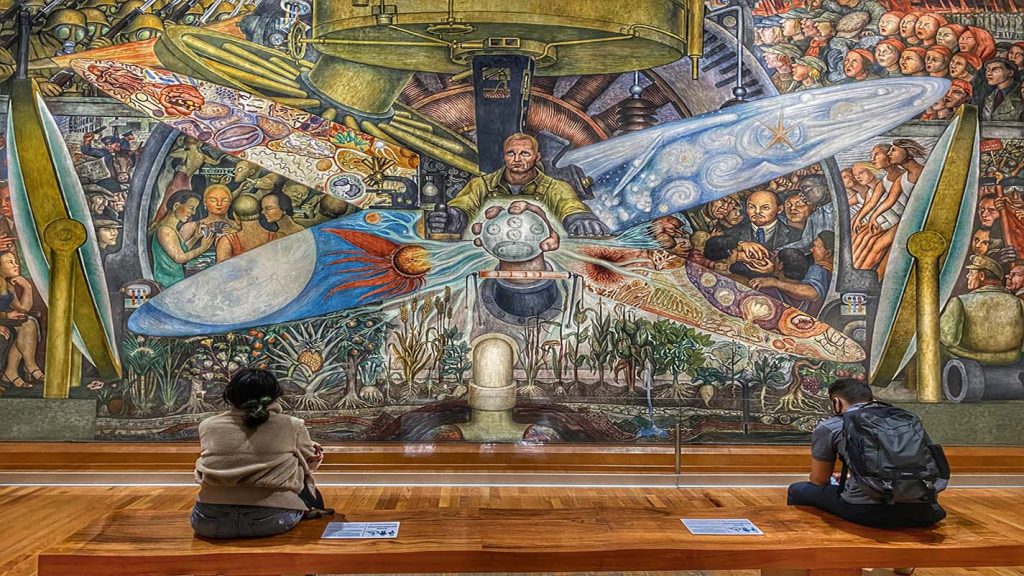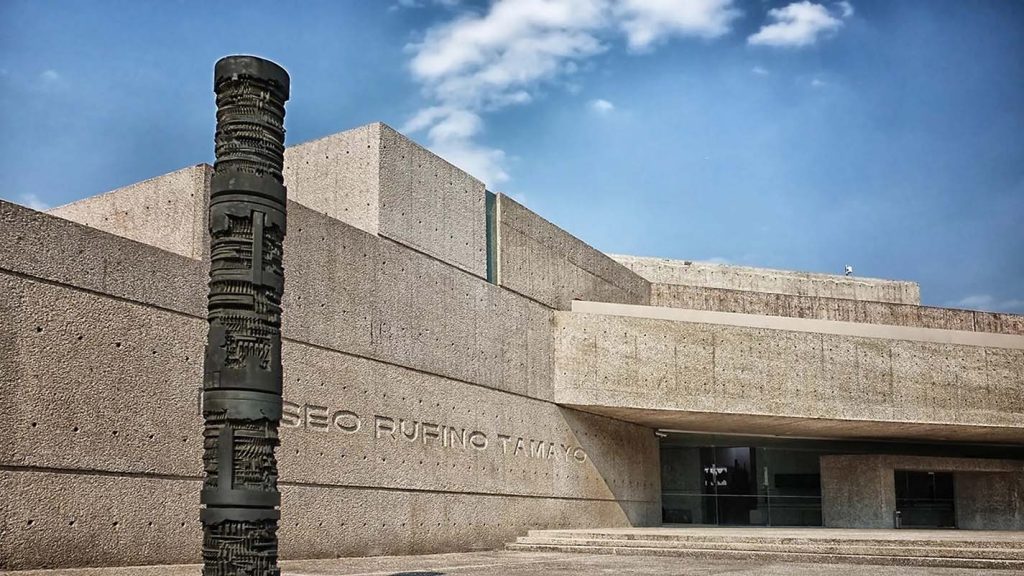Mexico City, often hailed as the “Paris of the Americas,” stands as a vibrant hub of culture with a thriving art scene and rich traditions of performance.My voyage through the galleries and theaters of Mexico City has been a captivating journey.I will share my personal encounters and recommendations for immersing yourself in the city’s lively arts and culture.
My Personal Artistic Highlights:
1. “Man at the Crossroads” by Diego Rivera

Description: Diego Rivera’s compelling mural, “Man at the Crossroads,” is a testament to his unique blend of social and political commentary. The mural depicts a crossroads where humanity faces choices between war and peace, science and destruction.
“Man at the Crossroads” was originally commissioned for the Rockefeller Center in New York City in the early 1930s. However, a dispute arose between Rivera and the Rockefellers over the inclusion of a portrait of Lenin in the mural. As a result, the mural was destroyed, but Rivera recreated it in Mexico City at the Palacio de Bellas Artes.
Location: This masterpiece resides at the Palacio de Bellas Artes.
Impressions: Standing in the presence of this work is a humbling experience. Rivera’s ability to convey intricate themes through art, coupled with the mural’s colossal scale and intricate details, makes it an absolute must-see for art aficionados.
As I entered the Palacio de Bellas Artes, I was immediately struck by the grandeur of the building itself. The museum’s architecture, with its impressive marble façade and exquisite Art Nouveau details, set the perfect stage for Rivera’s masterpiece.
Walking into the room housing “Man at the Crossroads,” I was captivated by the sheer size of the mural. It spans an entire wall, and the vivid colors and intricate details immediately draw you in. The mural is a testament to Rivera’s talent and his ability to convey complex ideas through art.
Rivera’s mural is a visual narrative of humanity’s struggles and choices at a crossroads in history. It depicts a central figure holding a blueprint of a new world, surrounded by various historical and symbolic elements. The juxtaposition of ancient and modern symbols underscores the pivotal moment in history when humanity must decide its path.
The attention to detail in “Man at the Crossroads” is staggering. From the depiction of famous figures like Lenin and Ford to the intricate machinery and scientific instruments, every element tells a story. Rivera’s use of vibrant colors and bold lines gives the mural a sense of energy and urgency.
As I stood before the mural, I couldn’t help but reflect on the themes it conveyed. Rivera’s exploration of social and political issues, his celebration of human potential, and his call for unity in the face of global challenges resonated deeply with me.
“Man at the Crossroads” is a masterpiece that transcends time and borders. Diego Rivera’s ability to tackle complex themes and present them in a visually stunning and thought-provoking manner is awe-inspiring. The mural is a must-see for anyone visiting Mexico City, offering a glimpse into the mind of one of the 20th century’s greatest artists.
My visit to “Man at the Crossroads” was a profound and enriching experience. It reminded me of the power of art to communicate profound ideas and spark meaningful conversations. If you find yourself in Mexico City, do not miss the opportunity to witness this incredible work of art and immerse yourself in the world of Diego Rivera.
2. “The Two Fridas” by Frida Kahlo
Description: Frida Kahlo’s “The Two Fridas” is a poignant exploration of her identity and emotions. The painting features two renditions of Kahlo, one in traditional Tehuana attire and the other in European-style dress, connected by intertwining blood vessels.
“The Two Fridas” (“Las Dos Fridas” in Spanish) was painted by Frida Kahlo in 1939, during a tumultuous period in her life. The painting is a double self-portrait, featuring two versions of Frida seated together against a stormy sky backdrop. The two Fridas are connected by an exposed artery, which is being cut by Frida Kahlo’s own hand in one version while being held by a surgical instrument in the other.
Location: This iconic artwork is on display at the Frida Kahlo Museum (Casa Azul).
Impressions: Witnessing “The Two Fridas” in person allowed me to truly grasp Kahlo’s emotional depth and her remarkable ability to express her inner turmoil through her art. The museum itself offers a glimpse into her tumultuous life.
As I stood before this masterpiece, I was immediately struck by the intensity of emotion conveyed by Frida Kahlo. The painting’s vivid colors and surreal elements create a dreamlike atmosphere, drawing the viewer into the artist’s inner world.
“The Two Fridas” is often interpreted as a representation of Frida’s emotional and physical pain. The two Fridas can be seen as two facets of her identity—one representing her Mexican heritage and the other her European roots. The exposed artery symbolizes vulnerability and the complex relationship between her heart and her pain.
Frida Kahlo’s use of bold colors and meticulous attention to detail is evident in this painting. Her self-portraits are a powerful form of self-expression, and “The Two Fridas” is no exception. The surreal elements, such as the stormy sky and the visible heart, add to the painting’s enigmatic quality.
“The Two Fridas” evokes a strong emotional response from viewers. Frida’s ability to convey her inner turmoil and vulnerability through her art is both haunting and captivating. It’s as if she bared her soul on the canvas, inviting us to witness her innermost struggles.
Standing before “The Two Fridas” was a deeply moving experience. It’s a testament to Frida Kahlo’s ability to channel her pain and emotions into her art, creating works that continue to resonate with audiences worldwide. This painting, in particular, is a testament to her artistic genius and her courage to confront her inner demons.
“The Two Fridas” is a masterpiece that offers a glimpse into the complex and tormented soul of Frida Kahlo. It’s a must-see for anyone visiting the Dolores Olmedo Museum in Mexico City, as it provides valuable insight into the life and art of this iconic artist. It left a lasting impression on me, reminding me of the power of art to convey the depths of human experience.
3. “Pyramid of the Sun” at Teotihuacan
Description: While not a traditional artwork, the Pyramid of the Sun at Teotihuacan is an architectural marvel from ancient times. Climbing this pyramid offers breathtaking panoramic views of the ancient city below.
Location: Teotihuacan is located just outside Mexico City.
Impressions: Ascending the Pyramid of the Sun was a humbling experience. It stands as a testament to the ingenuity of ancient civilizations and the enduring allure of historical sites.
Recommended Artistic Experiences:
1. “The Dream of a Sunday Afternoon in Alameda Park” by Diego Rivera
Description: Diego Rivera’s mural, “The Dream of a Sunday Afternoon in Alameda Park,” weaves the tapestry of Mexico City’s history through its people. The mural features historical figures, including Frida Kahlo and Porfirio Díaz, against the backdrop of the city’s narrative.
Location: The mural graces the walls of the Diego Rivera Mural Museum within the Hotel del Prado.
Impressions: Rivera’s ability to craft a multifaceted narrative through his art is vividly displayed here. The mural captures the essence of Mexico City’s history and its diverse cultural heritage.
2. Museo Tamayo

Description: Museo Tamayo is a haven for contemporary art enthusiasts, showcasing works by renowned Mexican and international artists. Its modern architecture seamlessly complements the innovative art it houses.
Location: Situated in Chapultepec Park.
Impressions: Museo Tamayo offers a vibrant playground for lovers of contemporary art. Its diverse exhibitions provide insight into the evolution of art in Mexico and beyond.
3. Ballet Folklórico de México
Description: The Ballet Folklórico de México stages captivating performances of traditional Mexican dance and music. The elaborate costumes, choreography, and music celebrate Mexico’s rich cultural tapestry.
Location: Performances take place at the Palacio de Bellas Artes.
Impressions: Attending a Ballet Folklórico performance feels like a journey through Mexico’s regions and history. The colorful costumes and accomplished dancers left me in awe.
4. Museo Frida Kahlo (Frida Kahlo Museum)
Description: Housed in Frida Kahlo’s former residence, this museum offers an intimate glimpse into her life and art. It features an extensive collection of Kahlo’s paintings, personal belongings, and artifacts.
Location: Located in the Coyoacán neighborhood of Mexico City.
Impressions: The museum provides a deeply personal connection to Frida Kahlo. Walking through her home studio and observing her art up close was an emotionally resonant experience.
Art and Culture in Mexico City
Mexico City’s art and culture scene reflect its rich history and abundant creativity. To make the most of your visits, it’s advisable to plan ahead, as some venues may have limited availability or require advance reservations.
Ticket Prices: Admission fees for museums and performances vary, with discounts often available for students, seniors, and children.
Booking Platforms:Consider using reputable booking platforms such as Ticketmaster or official museum websites for ticket purchases.
Immersing oneself in Mexico City’s art and culture is a rewarding and enriching experience. Whether you are an art enthusiast or a casual visitor, the city’s diverse offerings promise to leave an indelible mark on your heart and mind.
The city’s cultural treasures, combined with the warmth of its people, create an unforgettable experience that will linger with you long after you’ve bid farewell to its vibrant streets.